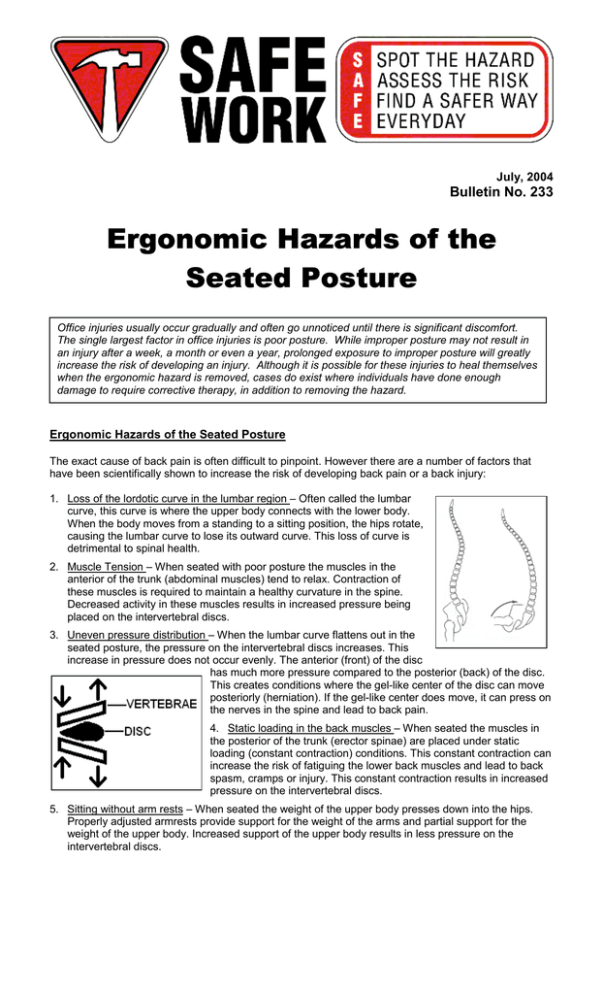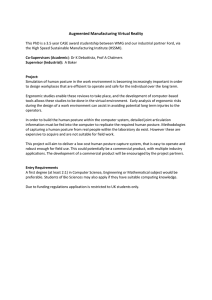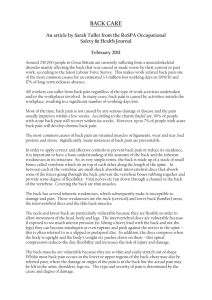Ergonomic Hazards of the Seated Posture
advertisement

July, 2004 Bulletin No. 233 Ergonomic Hazards of the Seated Posture Office injuries usually occur gradually and often go unnoticed until there is significant discomfort. The single largest factor in office injuries is poor posture. While improper posture may not result in an injury after a week, a month or even a year, prolonged exposure to improper posture will greatly increase the risk of developing an injury. Although it is possible for these injuries to heal themselves when the ergonomic hazard is removed, cases do exist where individuals have done enough damage to require corrective therapy, in addition to removing the hazard. Ergonomic Hazards of the Seated Posture The exact cause of back pain is often difficult to pinpoint. However there are a number of factors that have been scientifically shown to increase the risk of developing back pain or a back injury: 1. Loss of the lordotic curve in the lumbar region – Often called the lumbar curve, this curve is where the upper body connects with the lower body. When the body moves from a standing to a sitting position, the hips rotate, causing the lumbar curve to lose its outward curve. This loss of curve is detrimental to spinal health. 2. Muscle Tension – When seated with poor posture the muscles in the anterior of the trunk (abdominal muscles) tend to relax. Contraction of these muscles is required to maintain a healthy curvature in the spine. Decreased activity in these muscles results in increased pressure being placed on the intervertebral discs. 3. Uneven pressure distribution – When the lumbar curve flattens out in the seated posture, the pressure on the intervertebral discs increases. This increase in pressure does not occur evenly. The anterior (front) of the disc has much more pressure compared to the posterior (back) of the disc. This creates conditions where the gel-like center of the disc can move posteriorly (herniation). If the gel-like center does move, it can press on the nerves in the spine and lead to back pain. 4. Static loading in the back muscles – When seated the muscles in the posterior of the trunk (erector spinae) are placed under static loading (constant contraction) conditions. This constant contraction can increase the risk of fatiguing the lower back muscles and lead to back spasm, cramps or injury. This constant contraction results in increased pressure on the intervertebral discs. 5. Sitting without arm rests – When seated the weight of the upper body presses down into the hips. Properly adjusted armrests provide support for the weight of the arms and partial support for the weight of the upper body. Increased support of the upper body results in less pressure on the intervertebral discs. PAGE 2 ERGONOMIC HAZARDS of the SEATED POSTURE BULLETIN NO. 233 Ergonomic interventions to reduce the risk of pain and injury Taking breaks from the seated posture (reduce length of exposure to harmful postures) – There is an increased risk of injury to the body when one remains seated for longer than one (1) hour without a break. Research has also shown that there is an increased reporting of discomfort and pain when users are seated for five (5) or more hours accumulated throughout the day. For every hour of exposure to the seated posture one should take at least a five (5) minute break from sitting. The following are some tips that can be used to limit the exposure to the seated posture: 1. Use a timer as a reminder to get out of the chair. 2. Use a ringing phone as a cue to stand up and take a few steps. 3. Don’t leave all the fax/filing/mailing work until the end of the day – organize work tasks to allow a variety of tasks throughout the day. Placing, and locking the chair in a slightly reclined position – When sitting upright gravity pulls the upper body straight down into the hips. By locking the chair in a slight recline, gravity will pull the upper body into the backrest, reducing some of the compressive force in the intervertebral discs and the contraction required by the muscles of the lower back. Use lumbar support anytime you are exposed to the seated posture – Properly adjusted lumbar support is very important in the prevention of back pain. The W210 - Workplace Safety and Health Act States that: “Every employer shall: (a) provide and maintain a workplace, necessary equipment, systems and tools that are safe and without risks to health, so far as reasonably practicable and; (b) provide to all his workers such information, training, supervision and facilities to ensure, so far as reasonably practicable, the safety, health and welfare at work of all his workers.” **This legislation applies to the office environment, and especially to the provision of and proper adjustment of an appropriate office chair. A poor chair or a poorly adjusted chair can be a risk to health.** FEATURES OF A SAFE CHAIR Height adjustable lumbar support – Should be adjusted to the ‘small’ of the back, and feel like the chair is ‘pushing’ the back into neutral posture. Chair tilt – The chair should be adjustable in the amount of recline. The seat pan and backrest should be able to tilt together and lock in place if desired. Varying the amount of recline throughout the day will provide variety to the spine and intervertebral discs. Seat pan depth – The seat pan should not be so long as to press into the back of the knees while sitting in the chair with the back against the backrest. The seat pan should be appropriate for the size of user. Adjustable height – The overall height of the chair should be adjustable so that the user can operate a keyboard with the elbows at approximately 90º. If this brings the feet off the floor, a footrest should be used for support. Adjustable armrests – Should be located directly under the shoulders, at the level of the elbow. Adjustment should be set so that the arms feel supported but are not pushed upwards causing the shoulders to raise. Width of the arm rests shoulder be appropriate for the user’s body size. Five (5) casters – The chair should have a base with five prongs. Chairs with four (4) casters have been shown to be unsafe and should not be used. Illustrations courtesy of the Global Group Cette information existe également en français au www.gov.mb.ca/labour/safety/index.fr.html


